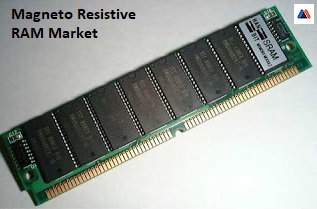5 July 2019: Global Magneto Resistive RAM (MRAM) Market is expected to reach USD 4.80 billion by 2025. MRAM is abbreviated as Magnetoresistive Random Access Memory, also termed as Magnetic RAM or Magneto-Resistive RAM, is a process of storing data bits using magnetic states. It uses a non-volatile random-access memory technology and is power efficient. The MRAM device is termed as a spintronics device. The Magneto Resistive RAM industry is estimated to grow at a significant CAGR over the forecast period as the scope and its applications are rising enormously across the globe.

Low power consumption, faster access time, and non-volatile data storage are documented as major factors of Magneto Resistive RAM Market that are estimated to enhance the growth in the years to come. However, memory density issue may restrain overall market growth in the coming years. MRAM industry is segmented based on types, end user, and region.
Toggle MRAM (T-MRAM) and spin-transfer torque (STT) MRAM are the types that could be explored in MRAM Market in the forecast period. The spin-transfer torque (STT) MRAM sector accounted for the significant market share of Magneto Resistive RAM (MRAM) industry and is estimated to lead the overall market in the coming years. The market may be categorized based on end users like robotics, enterprise storage, automotive, aerospace & defense, consumer electronics, and others that could be explored in the forecast period.
Globally, North America accounted for the largest market share of MRAM in terms of revenue and is estimated to lead the overall market in the coming years. The reason behind the overall market growth could be growth in research & development activities and presence of key manufacturers in the region.
Instead, Europe and the Asia Pacific are also estimated to have a positive influence on the future growth. Europe is the second largest region with significant market share. However, Asia Pacific is estimated to grow at fastest pace with the highest CAGR in the foremost period. The aspects that may be ascribed to the growth comprise growing advancements in infrastructures of data centers and rising acceptance of cloud computing. The developing countries like India and China are the major consumers of MRAM in the region.
The key players of Magneto Resistive RAM (MRAM) Market are Crocus Nanoelectronics, Avalanche Technology, and Everspin Technologies. These players are concentrating on inorganic growth to sustain themselves amongst fierce competition. As companies all over the world have to believe that alliance with a market would permit them proportional market existence and authority to declare the leadership position.
Browse Full Research Report with TOC@
https://www.millioninsights.com/industry-reports/magneto-resistive-ram-mram-market
https://www.millioninsights.com/industry-reports/magneto-resistive-ram-mram-market
Market Segment:
MRAM Type Outlook (Revenue, USD Million; 2014- 2025)
• Toggle MRAM
• Spin-Transfer Torque MRAM (STT-MRAM)
• Toggle MRAM
• Spin-Transfer Torque MRAM (STT-MRAM)
MRAM Application Outlook (Revenue, USD Million; 2014 - 2025)
• Consumer Electronics
• Robotics
• Automotive
• Enterprise Storage
• Aerospace & Defense
• Others
• Consumer Electronics
• Robotics
• Automotive
• Enterprise Storage
• Aerospace & Defense
• Others
MRAM Regional Outlook (Revenue, USD Million; 2014 - 2025)
• North America
• Europe
• Russia
• Asia Pacific
• RoW
• North America
• Europe
• Russia
• Asia Pacific
• RoW













